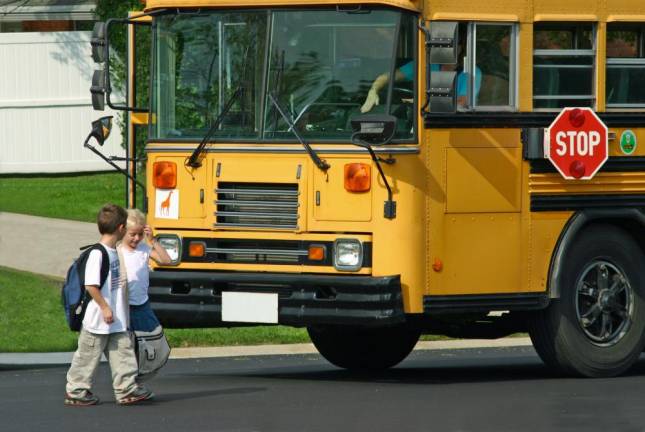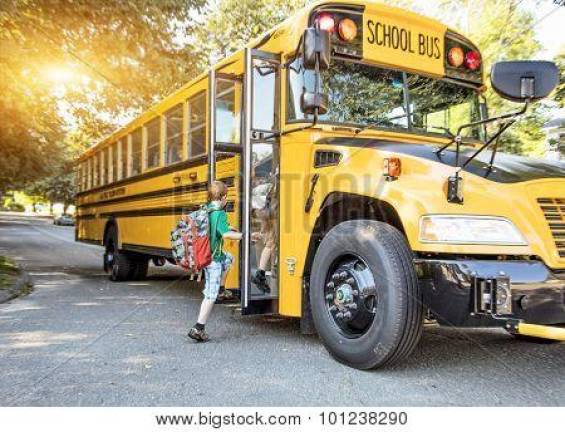The ABCs of bus stop safety
Buses. School buses are safe; getting on and off requires focus.


Designed with safety at the forefront, school buses are too heavy to roll over, too bright to miss and 70 times safer than cars.
Once kids are on the bus, critical injuries are vanishingly rare, with fewer than seven accident fatalities annually between 2013 and 2022, according to the National Highway Safety Administration.
But while students are waiting at bus stops, without the protection of a multi-ton crash-tested metal chassis, they are vulnerable to danger.
“There is an unsafe nature” to all bus stops these days, thanks to increasingly impatient and distracted drivers, said Kevin Hannon, transportation coordinator for Chester School District. School bus stop safety is particularly complicated here in the Northeast, where twisting, high-speed roads make visibility difficult.
School bus traffic rules
The biggest threat to school bus riders are drivers who disobey traffic laws.
School bus traffic laws follow a similar pattern to traffic lights:
When the yellow lights are activated, prepare to stop.
Stop when you see flashing red lights and do not go until the red lights are off.
The stop arm and the red lights are activated when the driver opens the door to let students on or off the bus. In New York, it is illegal to pass a stopped school bus when the red lights are flashing under most circumstances, including on the opposite side of a divided highway.
The laws in New Jersey and Pennsylvania are less strict. In New Jersey, drivers can pass a stopped school bus on the opposite side of a physical barrier, but they must slow down to 10 miles per hour. Drivers are also allowed to pass buses that are stopped in front of a school, if the bus is on the same side of the road as the school.
In Pennsylvania, drivers can proceed without stopping if they are driving on the opposite side of a clearly divided roadway as the bus.
Regardless of these exceptions, all 50 states have laws requiring drivers to stop for school buses when the red lights are flashing, and the stop arm is extended. These laws are in place to protect students from getting hit by an approaching vehicle.
“If (a student) were crossing the street and someone runs a red light, that could be a tragedy,” said Marvin Eversdyke, director of support services for Delaware Valley School District.
Students: ‘Don’t hurry. You’ll get there.’
Parents and students should brush up on a few simple bus stop rules at the beginning of each school year, said Hannon.
“It’s not a lot. Pay attention, don’t hurry on the bus, don’t hurry off the bus, hold the handrail, stay back, let the bus stop,” he said. “You’ll get there; school will be there.”
The most important reminder for students is to stay far away from the road while waiting for their bus, said Hannon.
“The bus has a 15-foot danger zone,” he said. “It’s a big bus. It’s 30 tons and it doesn’t stop on a dime.” If students aren’t at least 15 feet back from the road, the driver may not be able to see them and stop in time to avoid a tragedy.
If students have to cross the street, they must cross at least 15 feet in front of the bus. Make eye contact with the bus driver and wait to cross until the driver gives the hand signal indicating that it is safe.
Additionally, parents should make sure any loose strings are secured, and backpacks are well packed and fully zippered. If a child drops something, they may attempt to retrieve it from underneath the bus, where the driver cannot see them – a major hazard.
According to the New York State Department of Transportation, any items that a student is bringing on the bus must be able to fit comfortably on their lap. This means that large instruments, like a cello or saxophone, and some sports gears may not be allowed.
Students should understand that being able to ride the bus is a privilege that can be taken away, said Hannon.
“Do you do this in the classroom? This is a moving classroom,’” Hannon said. “We require the same behavioral recommendations you have in the classroom, and we try to do it even more because other people’s safety is involved.”
Drivers: Eliminate distractions and slow down
The professionals interviewed for this story unanimously agreed on how drivers can be safer around school bus stops: pay attention and don’t drive distracted.
Distractions include talking or texting on the phone, eating and drinking, talking to people in your vehicle, fiddling with the stereo, entertainment or navigation system, says the NHSA. Texting, which takes your eyes off the road for a full five seconds, is the most dangerous.
When a bus-related accident occurs, it’s usually obvious that a driver was unfocused. “We’ve all seen yellow lights on a school bus,” Hannon said. “They’re bright.”
Some drivers might “be concerned about whizzing by those yellows,” in an attempt to pass the bus before it stops. To this, Hannon says, “Slow down, in more ways than physical speed. Mentally slow down.”
Drivers need to be patient and understanding when they’re behind a school bus. They may not realize that students have been on the bus for a while; their stop might sneak up on them. It takes time to gather their belongings, say goodbye to friends, make their way up the aisle, carefully down the stairs and safely out of the road and to a parent or guardian.
Chester has a universal pre-K program, which means children as young as four may be riding the bus. An adult is required to meet preschoolers and kindergarteners at the bus stop, said Hannon, and drivers are trained to match each child to an adult.
A driver behind a school bus wouldn’t know that this process is taking place while they’re waiting, and although it takes a little longer, it ensures the safety of young bus-riders.
Many districts, like Delaware Valley, have plenty of “school bus stop ahead signs,” signaling drivers to be aware of frequent stopping and students. Often districts work with local police to keep bus routes safe, particularly those on high-speed roads, like 17M in Chester.
“If there is a complaint by the bus driver that a distracted driver or just an ignorant driver just went through the red on the bus stop, we will contact the police department, and they’ll follow the bus,” said Hannon. “They’ll do an undercover or hidden police car along that route, and they work very well with us.”
New York drivers should also be aware of a new program rollout from Orange County Executive Steve Neuhaus that plans to equip school buses countywide with AI-powered cameras to catch stop arm violators and record their license plates. First-time violators will be fined $250. Additional violations in the following 18 months will run up a $25 fine, which maxes out at $300.
At the end of the day, drivers need to understand that kids will be kids, and they may not follow the rules, which is why it’s so important for motorists to be extremely cautious driving near bus stops.
“Someday,” Hannon said, “your child might be on the other end of someone driving faster.”